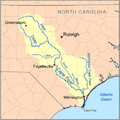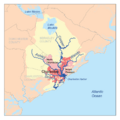Blockade runners of the American Civil War facts for kids
The blockade runners of the American Civil War were special ships used by the Confederacy. Their job was to sneak past the blockade set up by the Union Navy during the American Civil War. This blockade aimed to stop goods from reaching the Southern states.
On April 19, 1861, just a week after the war began, President Abraham Lincoln ordered this blockade. In response, the Confederacy used small, fast ships called blockade runners.
At first, the blockade wasn't very successful. About two out of every three ships trying to enter or leave Southern ports made it through. This was because the Union Navy had to patrol a huge coastline, nearly 3,500 miles long! But as the Union built more ships, the blockade became much stronger. Later in the war, only about 25% of blockade runners were successful.
Contents
Why the Blockade Happened
The blockade was a key part of General Winfield Scott's "Anaconda Plan". This plan aimed to put economic pressure on the Confederacy. The idea was to squeeze them until they rejoined the Union. It was the biggest blockade ever tried in history.
In 1861, the Southern states didn't have many factories. They couldn't make enough weapons and ammunition for their army. But they had lots of cotton, which was very valuable because it was grown using slave labor. The South sold cotton to England and France for their textile mills. In return, they needed to export this cotton to Europe and import arms and food for their soldiers. A successful blockade would stop this trade. This would make it very hard for the Confederate government to keep fighting.
Lincoln's Orders
President Lincoln made two important announcements about the blockade. On April 19, he announced a blockade of Southern ports from South Carolina to Texas. Then, on April 27, he added Virginia and North Carolina to the blockade.
His order said that Union ships would be placed to stop vessels from entering or leaving these ports. If a ship tried to break the blockade, it would first get a warning. If the same ship tried again, it would be captured, and its cargo would be taken as a prize.
Important Questions
Lincoln's blockade raised a big question: Was the South's action a rebellion or a full-blown war? Under the U.S. Constitution, it was seen as an "armed uprising" against the United States. This meant it was treason. However, when dealing with other countries, the U.S. called the Confederates "rebels" and not a separate nation at war.
Lincoln carefully chose his words. He saw the Southern states leaving the Union as an act of rebellion against democracy. He believed a small group of people had taken over Southern governments because they didn't like the results of the 1860 election. Lincoln wanted to show the world that a freely elected government could stop a rebellion.
In 1861, both the Confederacy and the Union wanted help from Great Britain. The North hoped Britain would help because Britain was against slavery. The South hoped for help because British factories needed their cotton. Both sides had diplomatic talks with Britain. The South especially needed Britain's help to win the war. Without Britain's support, France wouldn't dare get involved, even though they were friendly with the South.
On May 4, 1861, Queen Victoria of Britain announced that Britain would be neutral in the war. She also recognized the Confederacy as a "belligerent" in the conflict. This made Lincoln very angry. His Secretary of State, Seward, had already told the new U.S. representative in Britain to leave if the Queen recognized the Confederacy. France soon made a similar statement. Seward warned both nations that this could lead to war with the United States.
The Union Blockade in Action
When Lincoln first ordered the blockade, the United States Navy had fewer than 9,000 sailors. But by the end of 1861, it had grown to 24,000 men. The blockade was set up with groups of ships, called squadrons, at different points along the Southern coast. Each group watched a specific area.
Two early Union victories helped the blockade greatly. In April 1862, Union forces captured Fort Pulaski and Savannah, Georgia. A few weeks later, New Orleans was also captured. In August 1865, Mobile, Alabama, the last Confederate port in the Gulf of Mexico, fell to Union forces.
Confederate Blockade Runners
At first, all kinds of ships were used for blockade running. The most successful were steamboats that had lost their usual jobs because of the war. They could stay close to the coast and carry cotton to places like Cuba or The Bahamas. Then they would bring back other goods. This worked well early on because the Union Navy couldn't guard every part of the coast. These early blockade runners didn't need to be super fast or sneaky. Their captains knew the coast very well, which helped them avoid Union warships.
Cotton is usually picked in September and shipped during the winter and spring. When the blockade started in April 1861, most of that year's cotton had already been shipped. Only a small amount was left for the smaller ships to carry. The 1860 cotton crop had been huge, so there was plenty of cotton in the Northern states and in England. This meant there weren't huge profits to be made, or much money to buy war supplies. This actually helped the Union, even though the blockade wasn't very strong yet. Still, blockade runners could make some money, but not nearly as much as they would later.
As the war went on, more Union warships joined the blockade, and fewer Southern ports were available. Blockade running became a very specialized job. In 1863, 199 blockade runners made it to Confederate ports. In 1864, that number grew to 244. By 1865, near the end of the war, another 30 ships successfully delivered their goods.
More and more, this work depended on a very special type of ship. These were steamers built for speed. They could carry a lot of cargo and had a very low silhouette, making them hard to see from far away. The work was dangerous, but a successful trip could bring huge profits for the crews. These ships became the South's main way to trade with Europe. Without them, the Confederacy might not have lasted as long as it did. Even though it risked war with the United States, England secretly built several blockade runners for the South.
Images for kids
-
Blockade-runner mail to New Orleans via Nassau, Bahamas, stamped incoming ship 10-cents postage due.
-
CSS Atlanta, made many runs through the blockade carrying supplies for the Confederate army.
-
A Confederate blockade runner at anchor at St. George's, Bermuda.
-
James Dunwoody Bulloch (at left) shown with his half-brother Irvine Stephens Bulloch. James was the youngest officer on the CSS Alabama. They were the uncles of Theodore Roosevelt. Photo taken about 1865.
-
Wilmington on the Cape Fear River.
See also
 In Spanish: Evasión del bloqueo naval durante la guerra de Secesión para niños
In Spanish: Evasión del bloqueo naval durante la guerra de Secesión para niños













